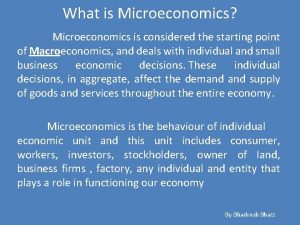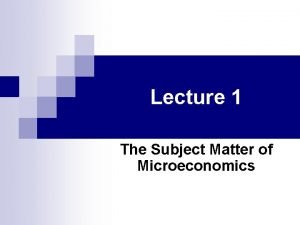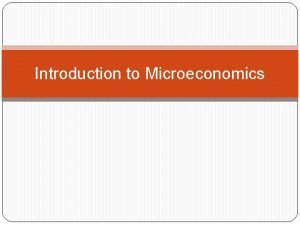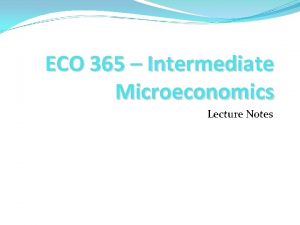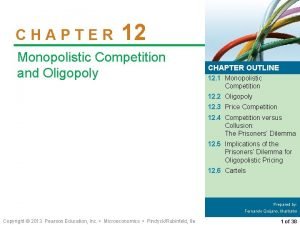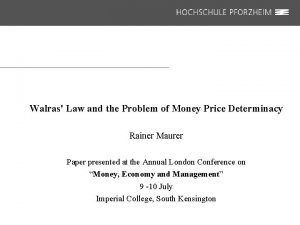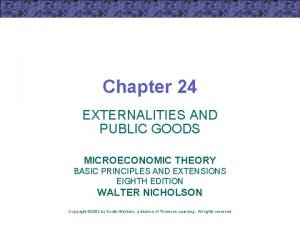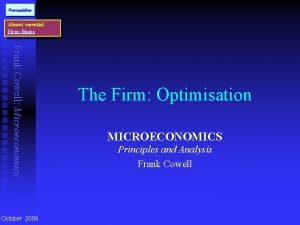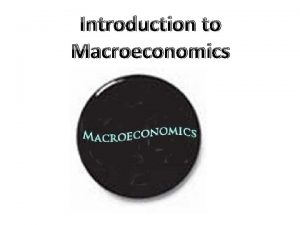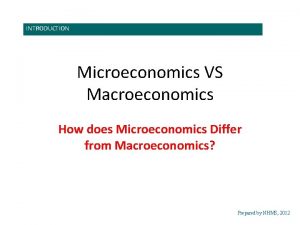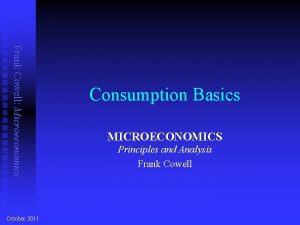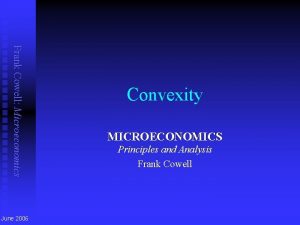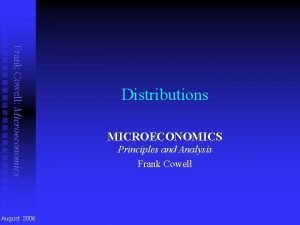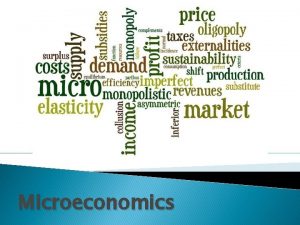Introduction to Microeconomics I A framework for dealing










- Slides: 10

Introduction to Microeconomics I. A framework for dealing with scarcity, human behavior, and social organization. II. Scarcity as a problem III. Production possibilities--our first economic model IV. Specialization--answer, but a challenge V. “Management” vs. “market” solutions VI. The circular flow of economic activity VII. “Doing economics”

I. Understanding economic news and issues requires. . • . . . a framework. That framework is called economics, which is the science that analyzes human behavior and social organization as a response to scarce resources and unlimited wants. • TIME OUT! A word about course requirements

II. Scarcity as a problem A. Scarcity as a personal issue. Example? B. Scarce resources as a business problem. Example? C. Scarce resources as a social problem: What, How, For Whom? D. Opportunity COST--what’s given up? E. So, scarcity implies tradeoffs. Example?

III. Production possibilities A. A word about models, assumptions, theories. [Start leaving space to fill in details and draw some graphs!] B. Production possibilities with non-increasing costs C. Production possibilities with increasing costs D. Society and scarcity: some examples of tradeoffs.

IV. Specialization • Division of labor makes us more productive • But it also creates a challenge--how do we coordinate all of our efforts so as to satisfy our wants without wasting resources?

V. “Management” vs. “Market” A. Personal decisions B. Business decisions C. Prices and opportunity costs D. And _____IT HAPPENS! E. So… where do we find the “management solution” instead?

VI. The Circular Flow of Economic Activity A. Two major sectors: firms and households B. “Real” flows of products and productive services. C. “Money” flows in the opposite direction D. Markets as decision and interaction points E. What have we left out? Oh, lots! F. Microeconomics and macroeconomics

The Circular Flow of Economic Activity

Time Out! Requirements • Textbook: Real Economics for Real People, by Charles L. Ballard • Coursepack: (Mostly) revised notes and old tests • Communicate with the instructor! --Weekly Manifest on the Web --Office hours, email, telephone, etc. Come to class regularly, and….

Did Someone Say Tests? • Eight Quizzes, mostly on Thursdays – Your two lowest scores are thrown out • Three Midterm Exams • Semi-comprehensive final exam, May 2 • (OK, let’s get back on the track of economics. Next slide. . . )
 What is microeconomics
What is microeconomics Objectives of macroeconomics
Objectives of macroeconomics What is the subject matter of microeconomics
What is the subject matter of microeconomics Limitations of macroeconomics
Limitations of macroeconomics Intermediate microeconomics lecture notes
Intermediate microeconomics lecture notes Intermediate microeconomics notes
Intermediate microeconomics notes Oligopoly model
Oligopoly model Walras’ law
Walras’ law Pure public good
Pure public good Frank cowell microeconomics solutions
Frank cowell microeconomics solutions Microeconomics michael parkin 13th edition
Microeconomics michael parkin 13th edition
